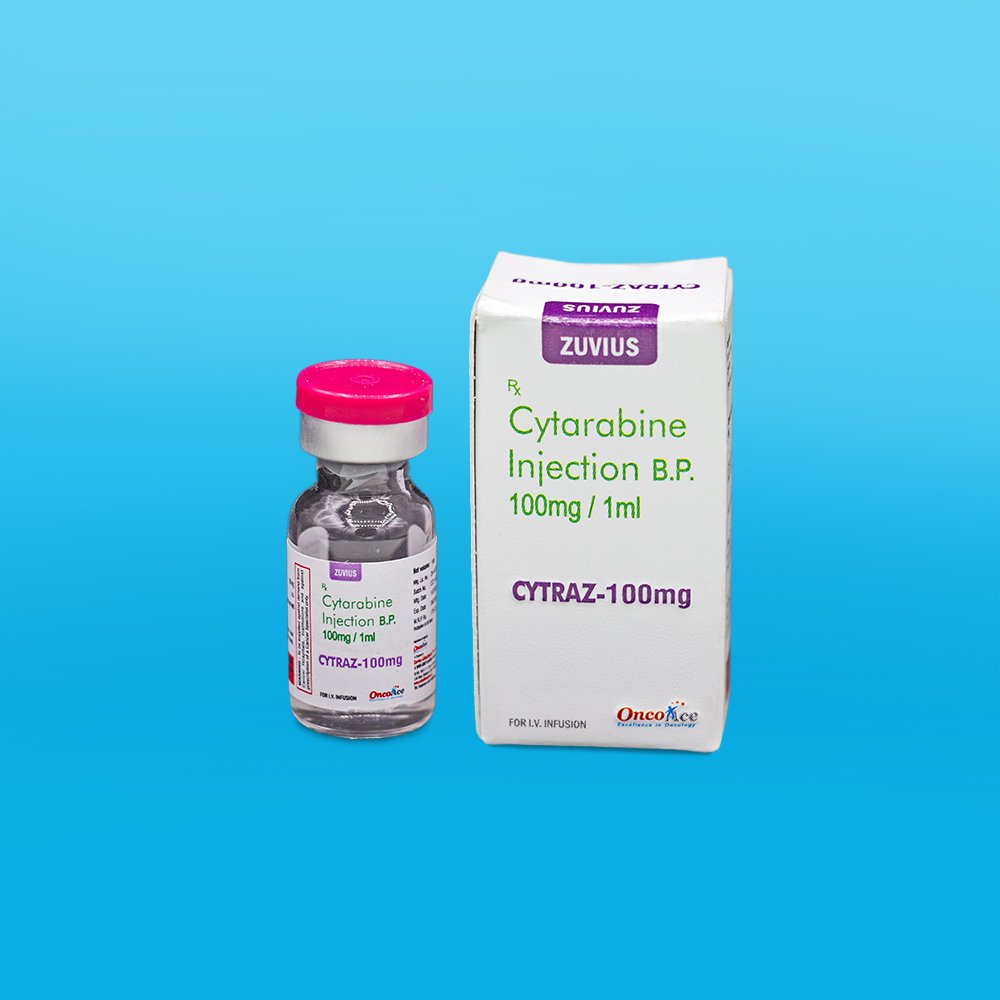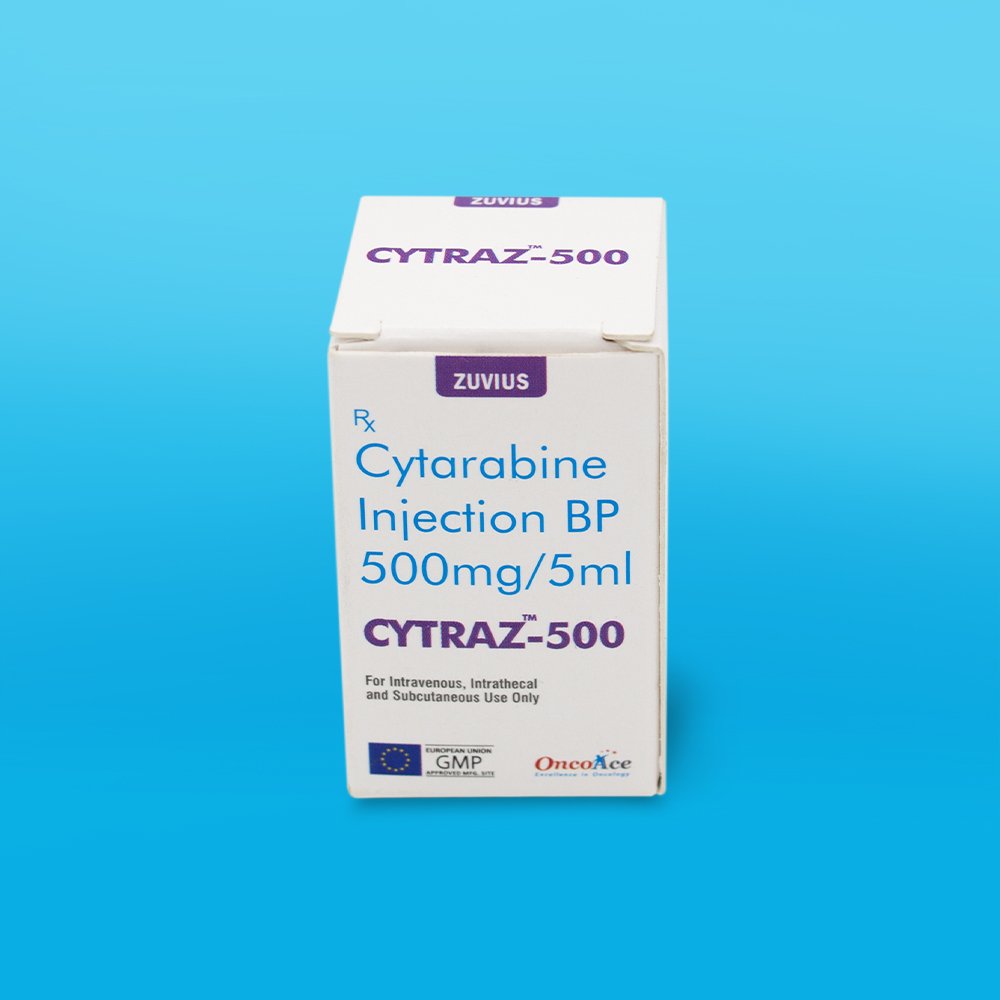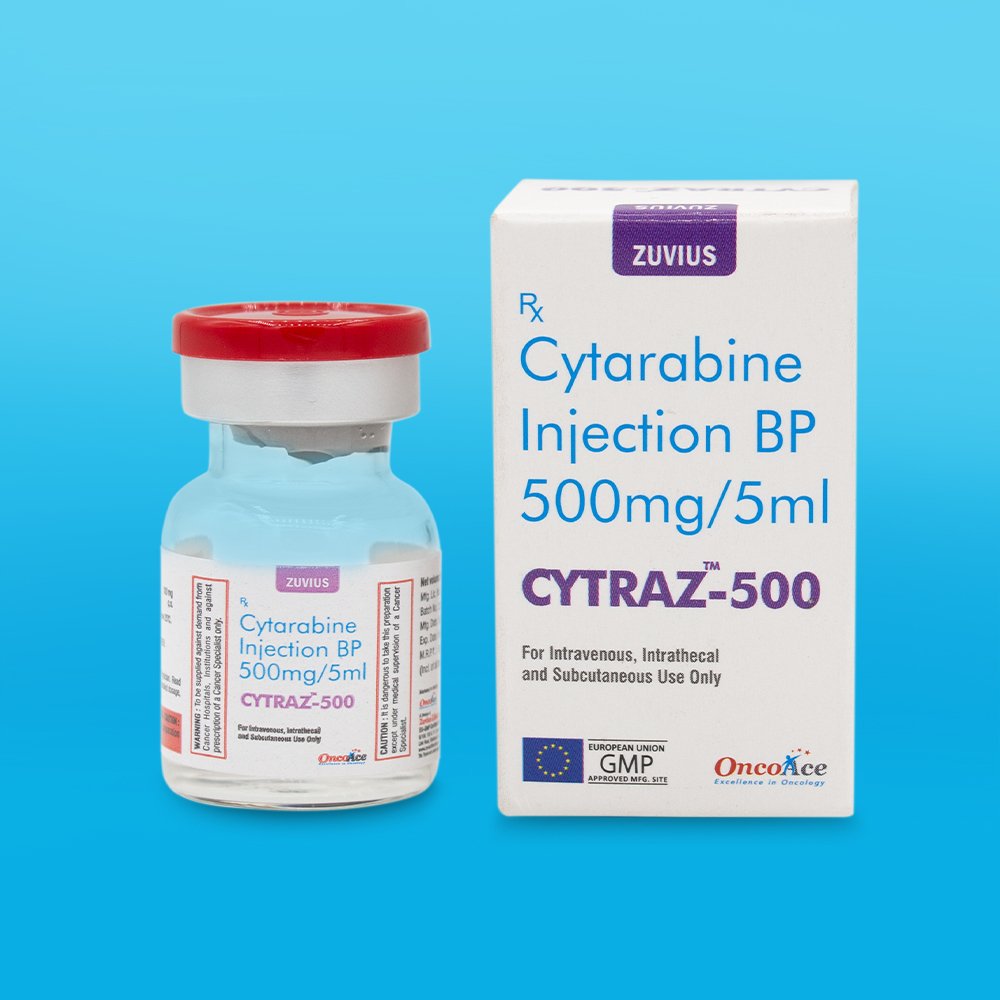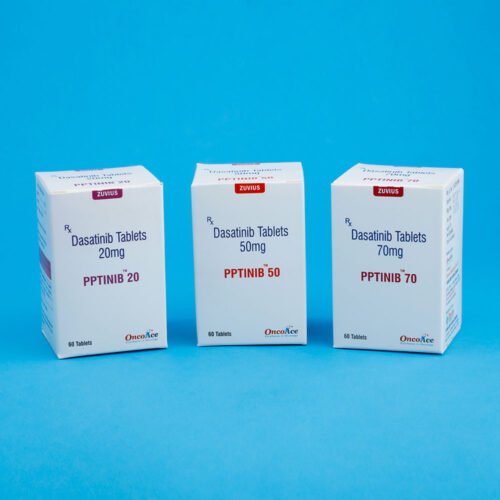Cytraz- Cytarabine Inj
Cytarabine
Strength: 100, 500, 1 gm
Pack Size: 1 vial
Drug Class: antimetabolites
Dosage and Administration:
Cytarabine Injection (non-preserved) can be administered by intravenous injection or infusion, subcutaneously, or intrathecally. However, the intent of this Pharmacy Bulk Package is for the preparation of solutions for IV infusion only. Intrathecal use of cytarabine requires the use of single-dose, unpreserved solutions only.
Cytarabine Injection is not active orally. The schedule and method of administration varies with the program of therapy to be used. While Cytarabine Injection may be given by intravenous infusion or injection, or subcutaneously or intrathecally, THE PURPOSE OF THE PHARMACY BULK PACKAGE IS FOR THE PREPARATION OF INTRAVENOUS INFUSIONS. Thrombophlebitis has occurred at the site of drug injection or infusion in some patients, and rarely patients have noted pain and inflammation at subcutaneous injection sites. In most instances, however, the drug has been well tolerated.
Patients can tolerate higher total doses when they receive the drug by rapid intravenous injection as compared with slow infusion. This phenomenon is related to the drug’s rapid inactivation and brief exposure of susceptible normal and neoplastic cells to significant levels after rapid injection. Normal and neoplastic cells seem to respond in somewhat parallel fashion to these different modes of administration and no clear-cut clinical advantage has been demonstrated for either.
In the induction therapy of acute non-lymphocytic leukemia, the usual cytarabine dose in combination with other anti-cancer drugs is 100 mg/m2/day by continuous IV infusion (Days 1-7) or 100 mg/m2 IV every 12 hours (Days 1-7).
The literature should be consulted for the current recommendations for use in acute lymphocytic leukemia.
Intrathecal Use in Meningeal Leukemia: Cytarabine has been used intrathecally in acute leukemia in doses ranging from 5 mg/m2 to 75 mg/m2 of body surface area. The frequency of administration varied from once a day for 4 days to once every 4 days. The most frequently used dose was 30 mg/m2 every 4 days until cerebrospinal fluid findings were normal, followed by one additional treatment. The dosage schedule is usually governed by the type and severity of central nervous system manifestations and the response to previous therapy.
If used intrathecally, do not use a solution containing benzyl alcohol. This pharmacy bulk package is not intended to be used for the preparation of intrathecal doses.
Cytarabine given intrathecally may cause systemic toxicity and careful monitoring of the hemopoietic system is indicated. Modification of other anti-leukemia therapy may be necessary. Major toxicity is rare. The most frequently reported reactions after intrathecal administration were nausea, vomiting and fever; these reactions are mild and self-limiting. Paraplegia has been reported. Necrotizing leukoencephalopathy occurred in 5 children; these patients had also been treated with intrathecal methotrexate and hydrocortisone, as well as by central nervous system radiation. Isolated neurotoxicity has been reported. Blindness occurred in two patients in remission whose treatment had consisted of combination systemic chemotherapy, prophylactic central nervous system radiation and intrathecal cytarabine.
When cytarabine is administered both intrathecally and intravenously within a few days, there is an increased risk of spinal cord toxicity, however, in serious life-threatening disease, concurrent use of intravenous and intrathecal cytarabine is left to the discretion of the treating physician.
Focal leukemic involvement of the central nervous system may not respond to intrathecal cytarabine and may better be treated with radiotherapy.
Chemical Stability of Infusion Solutions: Chemical stability studies were performed by a stability indicating HPLC assay on Cytarabine Injection in infusion solutions. These studies showed that when Cytarabine Injection was diluted with Water for Injection, 5% Dextrose Injection or Sodium Chloride Injection, in both glass and plastic infusion bags, 97-100% of the cytarabine was present after 8 days storage at room temperature.
This chemical stability information in no way indicates that it would be acceptable practice to infuse a cytarabine admixture well after the preparation time. Good professional practice suggests that administration of an admixture should be as soon after preparation as feasible.
Parenteral drugs should be inspected visually for particulate matter and discoloration prior to administration, whenever solution and container permit.
Handling and Disposal: Procedures for proper handling and disposal of anti-cancer drugs should be considered. Several guidelines on this subject have been published.1-7 There is no general agreement that all of the procedures recommended in the guidelines are necessary or appropriate.
Direction for Dispensing From Pharmacy Bulk Package: The 50 mL Pharmacy Bulk Package is for use in the Pharmacy Admixtures Service only. The vials should be inserted into the plastic handling device provided, suspended as a unit in the laminar flow hood.
A single entry through the vial closure should be made with a sterile dispensing set or transfer device. Transfer individual doses to appropriate intravenous infusion solutions. Use of a syringe with needle is not recommended. Multiple entries will increase the potential of microbial and particulate contamination.
Cold Storage: no
Cytarabine Injection, an antineoplastic, is a sterile isotonic solution for intravenous and subcutaneous use, which contains no preservative and is available in 20 mg/mL (1000 mg/50 mL) Pharmacy Bulk Package.
A Pharmacy Bulk Package is a container of a sterile preparation for parenteral use that contains many single doses. The contents are intended for use in a pharmacy admixture program and are restricted to the preparation of admixtures for intravenous infusion.
Each mL contains 20 mg Cytarabine, USP and the following inactive ingredients: sodium chloride 0.68% and Water for Injection q.s. When necessary, the pH is adjusted with hydrochloric acid and/or sodium hydroxide to a target pH of 7.4. Each vial contains approximately 5.82 mEq sodium.
Cytarabine is chemically 4-amino-1-β-D-arabinofuranosyl-2(1H)-pyrimidinone. The structural formula is:
Cytarabine in combination with other approved anticancer drugs is indicated for remission induction in acute non-lymphocytic leukemia of adults and children. It has also been found useful in the treatment of acute lymphocytic leukemia and the blast phase of chronic myelocytic leukemia. Intrathecal administration of cytarabine is indicated in the prophylaxis and treatment of meningeal leukemia.
Cytarabine is cytotoxic to a wide variety of proliferating mammalian cells in culture. It exhibits cell phase specificity, primarily killing cells undergoing DNA synthesis (S-phase) and under certain conditions blocking the progression of cells from the G1 phase to the S-phase. Although the mechanism of action is not completely understood, it appears that cytarabine acts through the inhibition of DNA polymerase. A limited, but significant, incorporation of cytarabine into both DNA and RNA has also been reported. Extensive chromosomal damage, including chromatoid breaks, have been produced by cytarabine and malignant transformation of rodent cells in culture has been reported. Deoxycytidine prevents or delays (but does not reverse) the cytotoxic activity.
- Oxaliplatin should not be mixed with any other medication and it should not be administered simultaneously by the same infusion line.
- Caution is recommended while administering Oxaliplatin to patients with known hypersensitivity to other platinum agents.
- It is known whether oxaliplatin is excreted in human milk or not caution should be exercised when oxaliplatin is administered to a nursing woman as many drugs are excretedPatients receiving Cytarabine Injection must be monitored closely. Frequent platelet and leukocyte counts and bone marrow examinations are mandatory. Consider suspending or modifying therapy when drug-induced marrow depression has resulted in a platelet count under 50,000 or a polymorphonuclear granulocyte count under 1000/mm3. Counts of formed elements in the peripheral blood may continue to fall after the drug is stopped and reach lowest values after drug-free intervals of 12 to 24 days. When indicated, restart therapy when definite signs of marrow recovery appear (on successive bone marrow studies). Patients whose drug is withheld until “normal” peripheral blood values are attained may escape from control.When large intravenous doses are given quickly, patients are frequently nauseated and may vomit for several hours postinjection. This problem tends to be less severe when the drug is infused.The human liver apparently detoxifies a substantial fraction of an administered dose. In particular, patients with renal or hepatic function impairment may have a higher likelihood of CNS toxicity after high-dose cytarabine treatment. Use the drug with caution and possibly at reduced dose in patients whose liver or kidney function is poor.Periodic checks of bone marrow, liver and kidney functions should be performed in patients receiving Cytarabine Injection.Like other cytotoxic drugs, Cytarabine Injection may induce hyperuricemia secondary to rapid lysis of neoplastic cells. The clinician should monitor the patient’s blood uric acid level and be prepared to use such supportive and pharmacologic measures as might be necessary to control this problem.Acute pancreatitis has been reported to occur in a patient receiving cytarabine by continuous infusion and in patients being treated with cytarabine who have had prior treatment with L-asparaginase.in human milk.
- Inspect the solution visually for particulate matter and discoloration prior to administration.
Check with your doctor immediately if you notice any unusual bleeding or bruising; black, tarry stools; blood in urine or stools; or pinpoint red spots on your skin. Be careful when using a regular toothbrush, dental floss, or toothpick.














